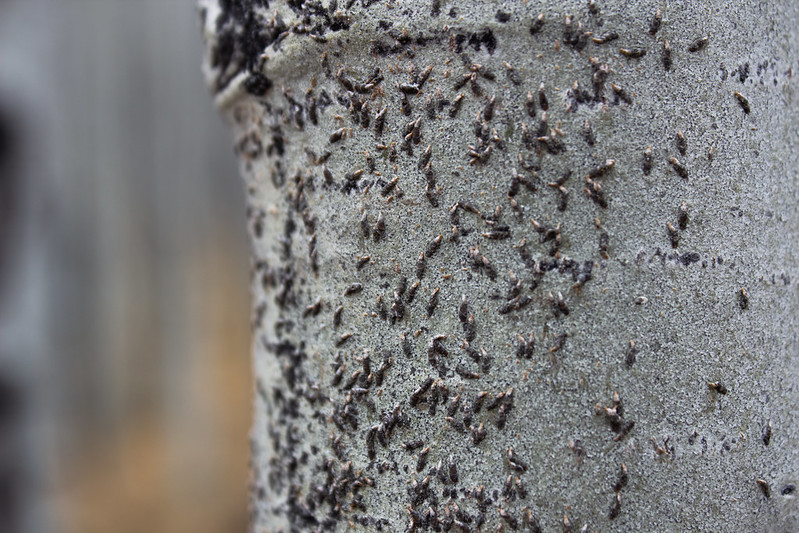Dogwood trees add year-round color and texture to a landscape while being incredibly easy to maintain. Flowering varieties are a natural focal point during the spring, but the foliage and bark help these shrubs stand out throughout all four seasons.
Dogwood is susceptible to several pests, and the damage can range from purely cosmetic to death. Discovering an infestation can be heartbreaking, but most of the time, treatment is effective. Here is how to spot the signs of pests and take steps to remedy an infestation and prevent future outbreaks.
Common Dogwood Pests
Dogwood Borers
Dogwood borers are the larval stage of a moth. The female moth enters the interior of the branches through wounds or damage to the bark, and lays her eggs. The eggs hatch, and the larvae feed on the growth layer of the branch, causing leaves and bark to die and fall off, followed by death of branches.
Small trees will likely die within a few years of the dogwood borers entering the branches if left untreated. Older, established trees may withstand these bugs but will experience stunted growth and visible damage to their bark.

Photo by Thomas Shahan, unedited, Flickr, Copyright CC BY 2.0 DEED
Treating Dogwood Borers on Dogwood
Treat dogwood borers by removing infected branches. Burn the branches to kill the eggs and larvae and prevent further spread. Spray the dogwood with an insecticide to treat any eggs or larvae that are not seen.
Preventing Dogwood Borers on Dogwood
Avoid damaging the bark when possible. Mature pests enter the tree through holes or openings in the bark, so eliminating openings when possible protects the dogwood. Spray damaged and opened bark with insecticide to discourage pests from infesting the tree. Be extra vigilant in spring, when the adult pests are looking for a place to lay eggs.
Scale
Scale are oval-shaped pests that suck sap from dogwood, causing leaves and shoots to die. Several different varieties of scale can infest dogwood. Some scale pests have a hard shell, while others are soft bodied. A scale infestation is unlikely to kill a dogwood, especially a mature plant, but it will stunt growth and lead to dead foliage.

Treating Scale on Dogwood
Spraying a dogwood with water is often enough to dislodge scale. While physically removing the pests will help a particular plant, the scale will return or move on to a nearby plant. For more severe infestations, spray the plant with an insecticidal soap. Spray the dogwood every other week or after a rain storm to kill eggs and larvae and discourage more pests from infesting the tree.
Preventing Scale on Dogwood
Entice predatory insects, like ladybugs, to keep scale away. Spray the plant with an insecticidal soap early in the spring to kill any scale eggs or larvae. Use an insecticidal soap if you have previously struggled with scale, but remember it will also kill beneficial insects, so find a preventative method that works for your situation.
Club Gall Midges
Club Gall Midges are a type of fly that lays their eggs in dogwood foliage at the end of the branches. After the eggs hatch, the larvae eat the new growth and cause the branches to swell at the tips. These pests cause leaves to wilt or become disfigured. A small infestation will stunt growth and cause some branches to appear deformed. A severe infestation will kill all new growth.

Photo by Tom Murray
Treating Club Gall Midges on Dogwood
Treat dogwood club gall midges by pruning the swollen branch tips as they become visible. Do not throw the clippings into compost. Burning is an effective way to kill the pests and prevent further infestation.
Preventing Club Gall Midges on Dogwood
Regular applications of insecticidal soap will prevent midges on dogwood. Apply a preventative product in the spring because that is when adult bugs lay eggs. Creating an inhospitable environment will send adult midges on their way, protecting your plants.
Sawflies
Sawflies lay eggs on dogwood leaves; when those eggs hatch, the caterpillar-like larvae that emerge will devour foliage. A heavy infestation of sawfly larvae can defoliate a dogwood. Trees need leaves to conduct photosynthesis; losing most or all of the leaves can severely stunt growth and even kill a tree. By fall, the caterpillars burrow into the wood. The larvae reappear as adult sawflies in the spring and lay eggs on the leaves, starting the process all over.

Photo by Dave Lage, unedited, Flickr, Copyright CC BY-SA 2.0 DEED
Treating Sawflies on Dogwood
You can manually remove and crush the larvae to kill them. Plucking these worm-like pests from the plant may minimize damage, but you will likely be unable to locate and kill all of them. Treat sawflies by spraying an infested dogwood with insecticidal soap in the spring after you see the larvae. It may take several rounds of treatment to kill them, so be diligent.
Preventing Sawflies on Dogwood
Prevent sawflies by preemptively spraying a dogwood with insecticidal soap. Preventative measures are often only necessary if you have previously had trouble with sawflies. Adult sawflies lay eggs in the spring, so spraying a dogwood early in the growing season will cause the sawflies to find a more inviting plant to inhabit.
Dogwood Pests Chart
|
Pest |
Identifying |
Treating |
|
Dogwood Borers |
Larvae look like white grubs; adults are clear-winged moths with a wasp-like body |
Remove and burn infected branches |
|
Scale |
Oval-shaped pests with hard shell while others soft-bodied |
Spray with insecticidal soap every other week |
|
Club Gall Midges |
Small flies causing abnormal growths on plants |
Prune the swollen branch tips as they become visible |
|
Sawflies |
Resembles a caterpillar, with a cylindrical body and numerous prolegs |
Manually remove larvae; pray with insecticidal soap |
Sources: "Dogwood Diseases and Insect Pests." Clemson University, Clemson Cooperative Extension. hgic.clemson.edu
 |
Author Alison Cotsonas - Published 01-12-2024 |
